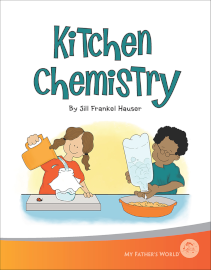Kitchen Chemistry is based on Jill Frankel Hauser’s book Super Science Concoctions. My Father’s World has reformatted and edited this out-of-print book, improving it with larger, full-color pages that make it easier to read, and a spiral binding that lets it lie flat while you lead children through experiments. The book retains the original cartoon illustrations by Michael Kline. All of this makes Kitchen Chemistry even better than the original and a terrific resource for homeschoolers.
My Father’s World includes the book as part of their third-grade package, World Changers, but it can be used with children from about kindergarten through fifth grade. It should be great fun to use together as a family.
The book has 34 lessons, each beginning with a fun, hands-on experiment or activity. Through the experiments, students observe and discover scientific principles that are explained in the lessons. Additional explorations and activities extend the lessons with lots more hands-on learning. Most lessons also include practical applications and curious bits of information, so children learn how scientific principles apply in real life.
Kitchen Chemistry is a great title for this book since you should find most of what you need in your kitchen—like salt, cornstarch, gelatin, oil, chocolate chips, straws, coffee filters, and a stove. A few items, like white glue, felt-tip pens, art paper, rubbing alcohol, and string, might be found among school and household supplies. Only a few items (i.e., Epsom salts, Borax, and pipe cleaners) might not be on hand but are easy to obtain. Page 11 in the book suggests homemade substitutes for science lab equipment, such as using a straw as an eye dropper, making a test tube holder from an empty cracker box, and using clear floral vials or small jars as test tubes.
The lessons are presented under five section headings:
- Molecules and Solutions
- Phase Changes
- Chemical Changes
- Liquids
- Globs of Fun—Polymers, Colloids, and More…
Some sections focus on one main concept through several activities while others introduce several concepts. For example, Chemical Changes focuses primarily on acids and bases with several activities using different types of indicators. The much larger section on liquids teaches several concepts such as density, the effect of heat on liquids, cohesion, adhesion, capillary action, surface tension, and the structure of bubbles.
Concepts are taught at an introductory level but can be taken deeper with the extension activities and explanations in the book. Young children can participate as much as possible, while older children can be drawn into discussion of the principles and further explorations. For example, the unit on chemical changes focuses primarily on acids and bases. (It does not teach about valences or bonds.) Children begin by making a baking soda and vinegar volcano and are introduced to the creation of carbon dioxide. Young children might also observe what happens when they put raisins in soda (dancing raisins) and consider the carbon dioxide bubbles that produce the texture of cake. Older students can go further by creating a boat propelled by vinegar and baking soda out of a two-liter soda bottle. Parents need to supervise experiments, read and discuss information from the book and the experiments, and encourage children as they do further explorations.
Scientific vocabulary words such as colloids, aerosols, emulsions, and thixotropy are introduced gently along with goofy words for some of the concoctions children create, such as blubberscotch, gooblek, and blobber. Students aren’t expected to master all the vocabulary at this introductory level.
At the front of the book are four pages of introductory information, including an explanation of the scientific method. This includes recording observations from experiments. However, there are no charts or recording pages in the book, and it is left to parents to decide if and how students might record information or write up lab reports. Personally, I would use Kitchen Chemistry to get children excited about science and inspired to do further explorations without worrying about lab reports.
Summary
Kitchen Chemistry should be great for homeschooling parents who want to introduce science concepts through experiments, using children’s curiosity and wonder to inspire them to learn more.








